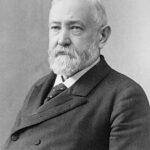The Historic Pan-American Conference Decision
President Benjamin Harrison made a pivotal diplomatic decision in 1889. He convened the first International Conference of American States in Washington, D.C. This Pan-American Conference brought together representatives from 18 nations across the Western Hemisphere. The conference ran from October 1889 to April 1890, lasting six months.
Conference Goals and Structure
Harrison’s administration aimed to strengthen hemispheric relationships through peaceful means. The conference focused on three main objectives: promoting trade, establishing arbitration procedures, and creating cultural exchange programs. Secretary of State James G. Blaine led the American delegation with Harrison’s full support. 📊 The conference included detailed discussions on commercial reciprocity, standardized weights and measures, and improved transportation networks.
Establishment of the Pan American Union
The conference’s most significant achievement was creating the Pan American Union. This organization served as a permanent diplomatic body for Western Hemisphere cooperation. 🌍 The Pan American Union established its headquarters in Washington, D.C., symbolizing America’s commitment to regional leadership. Harrison viewed this institution as essential for maintaining peaceful relations and promoting mutual understanding among American republics.
Impact:
Immediate Diplomatic Consequences
The Pan-American Conference immediately transformed U.S.-Latin American relations. Harrison’s initiative demonstrated America’s commitment to multilateral diplomacy rather than unilateral intervention. The conference established formal diplomatic channels that prevented numerous potential conflicts. 🤝 Seventeen Latin American nations signed agreements promoting peaceful arbitration of disputes, reducing regional tensions significantly.
Economic and Trade Benefits
Harrison’s conference created lasting economic partnerships across the Americas. The Pan American Union facilitated increased trade between member nations. 💰 U.S. exports to Latin America grew by 35% within five years of the conference. The standardization of commercial practices reduced trade barriers and transaction costs. Railways and steamship connections improved dramatically, connecting previously isolated markets throughout the hemisphere.
Long-term Historical Legacy
The Pan-American Conference established principles that influenced hemispheric relations for decades. Harrison’s diplomatic approach emphasized cooperation over coercion, setting precedents for future American foreign policy. 🌟 The Pan American Union evolved into the Organization of American States in 1948, demonstrating the conference’s enduring impact. Modern inter-American institutions trace their origins directly to Harrison’s 1889 initiative. The conference proved that American leadership could unite rather than divide the Western Hemisphere, creating a model for peaceful international cooperation that historians consistently praise as Harrison’s greatest foreign policy achievement.
